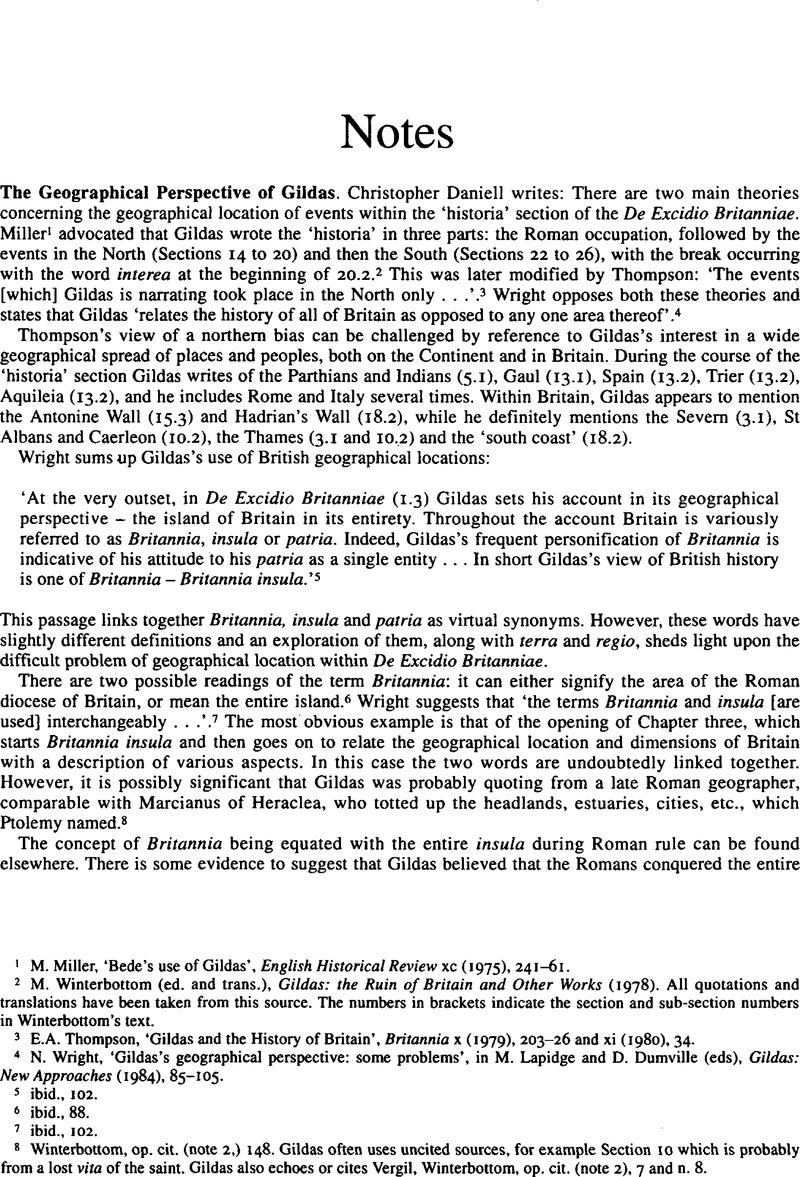No CrossRef data available.
Article contents
The Geographical Perspective of Gildas
Published online by Cambridge University Press: 09 November 2011
Abstract

- Type
- Notes
- Information
- Copyright
- Copyright © Christopher Daniell 1994. Exclusive Licence to Publish: The Society for the Promotion of Roman Studies
References
1 Miller, M., ‘Bede’s use of Gildas’, English Historical Review xc (1975), 241–61.CrossRefGoogle Scholar
2 M. Winterbottom (ed. and trans.), Gildas: the Ruin of Britain and Other Works (1978). All quotations and translations have been taken from this source. The numbers in brackets indicate the section and sub-section numbers in Winterbottom's text.
3 Thompson, E.A., ‘Gildas and the History of Britain’, Britannia x (1979), 203–26 and xi (1980), 34.CrossRefGoogle Scholar
4 N. Wright, ‘Gildas's geographical perspective: some problems’, in M. Lapidge and D. Dumville (eds), Gildas: New Approaches (1984), 85-105.
5 ibid., 102.
6 ibid., 88.
7 ibid., 102.
8 Winterbottom, op. cit. (note 2,) 148. Gildas often uses uncited sources, for example Section 10 which is probably from a lost vita of the saint. Gildas also echoes or cites Vergil, Winterbottom, op. cit. (note 2), 7 and n. 8.
9 Thompson, op. cit. (note 3), 204 notes that Gildas's use of the word ‘lioness’ (leaenae) is used ‘to denote a country’. The text seems inconclusive as to whether a country or particular person is intended. The word is used three times, in each case to depict evil: the revolt against Rome by the British was led by a ‘treacherous lioness’ (6.1), the ‘mother lioness’ sent more Saxons to Britain (23.4), and Constantine was the ‘whelp of the filthy lioness of Dumnonia’ (28.1). Whether there is any particular significance that the word is feminine is debatable. If general evil is implied the supposed mention of the revolt by Boudicca (6.1) may alternatively be the resistance that centred on Anglesey.
10 Wright, op. cit. (note 4), 88-92, also implied this conclusion in his detailed study of the incursions by the Picts and Scots. I am grateful to K. Hunter-Mann for this point and many valuable comments.
11 Wright, op. cit. (note 4), 102, Thompson, op. cit. (note 3), 216-17, and D. Dumville, ‘The chronology of the De Excidio Britanniae Book 1’, in M. Lapidge and D. Dumville (eds), Gildas: New Approaches (1984), 61-84.
12 Wright, op. cit. (note 4), 102.
13 The term is used only once outside the ‘historia’ section, in 35.6, as part of a quote: ‘Indeed, as the prophet has said, “the just king establishes the land” (regionem)’.
14 This implies that there was an authority to ‘inform’ and might be an indirect reference to the council.
15 Except for the use of patria as part of a prophecy (21.5), the word is not used again until 23.1.
16 Dumville, op. cit. (note 11), 61-84.
17 Ambrosius himself may have been from the patria. The last time the word is used in a historical setting is when Gildas says ‘Others held out … in their own land (patriae)’ (25.1) which is then followed by a description of people flocking to them (25.2) and that their leader was Ambrosius (25.3). The battle of Mount Badon is not located (26.1).
18 This is in direct contrast to Thompson, op. cit. (note 3), 217 who states, ‘the [Saxons] must have been settled in the east of Northumbria’.
19 D. Dumville, ‘Gildas and Maelgwn: problems of dating’, in M. Lapidge and D. Dumville (eds), Gildas: New Approaches (1984), 51-9.
20 Gildas mentions the ‘partition of the barbarians’ without giving details of who the ‘barbarians’ were. He might simply mean ‘non-Christians’ for the term ‘barbarian’ is used for both the Picts (20.1) and the Saxons (23.5). It is also used in a more general sense, for example the Romans built towers on the south coast as they were afraid of attacks by ‘barbarians’ (18.3) and the letter to Aetius twice mentions ‘barbarians’ (20.1). If the shrines were in the hands of native non-Christian kings then they could still be in the patria, although the use of the term ‘partition’ (divortio) gives an impression of a planned and cross-country boundary.


